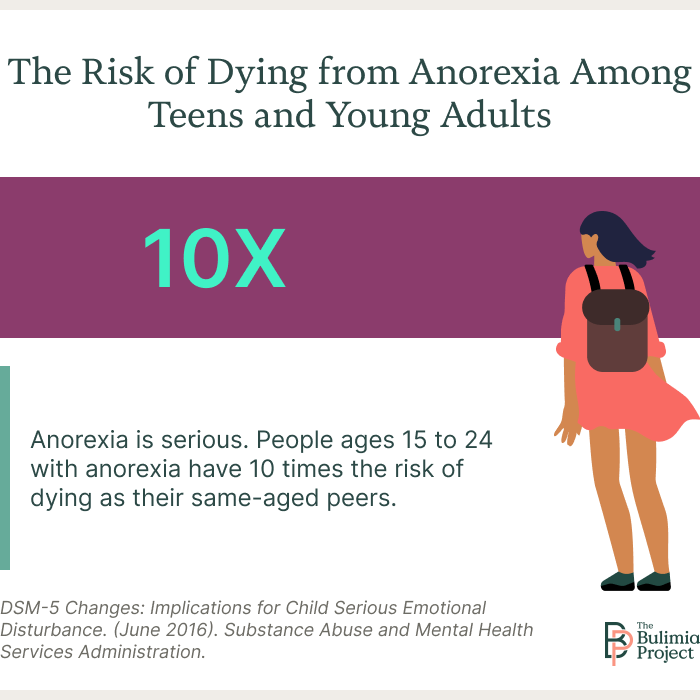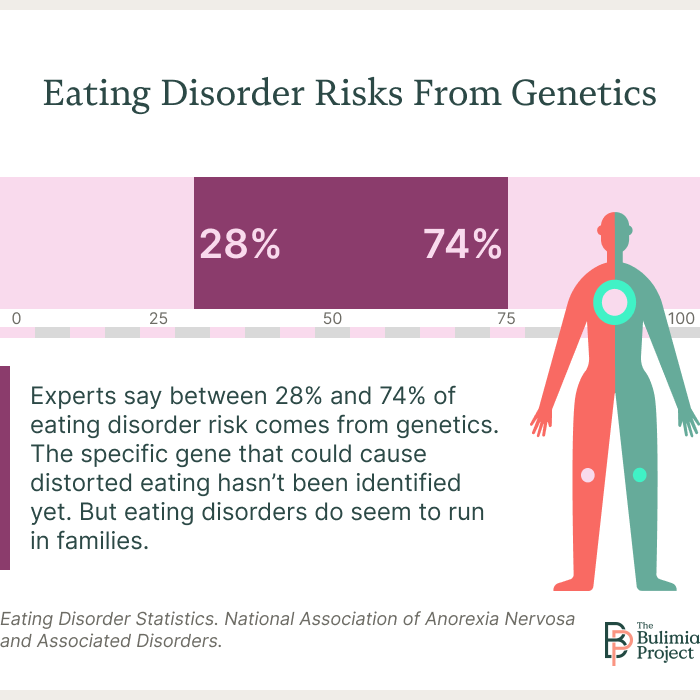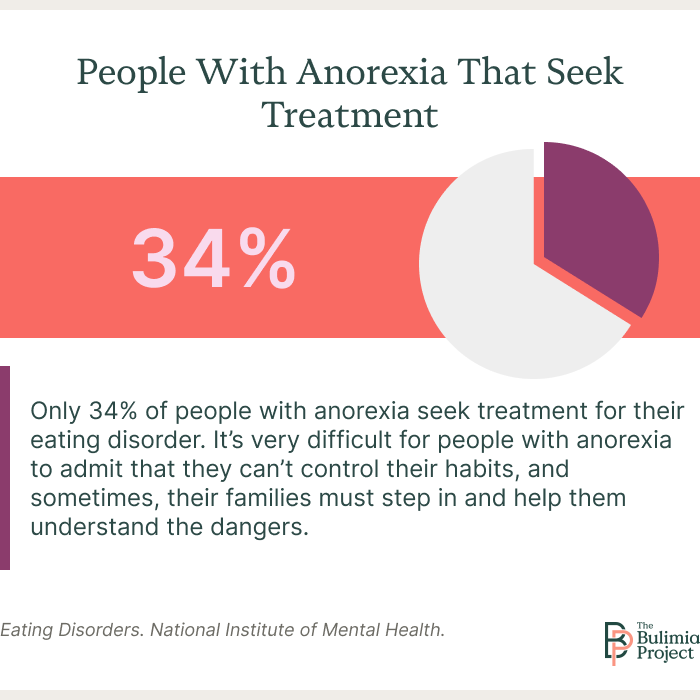Anorexia is serious. People ages 15 to 24 with anorexia have 10 times the risk of dying as their same-aged peers. (1)
Many people with anorexia struggle in silence, but it doesn’t have to be that way. Treatment programs can make a huge difference in the life of someone with anorexia.

What Is Anorexia? A Formal Definition
The American Psychiatric Association published the Diagnostic and Statistical Manual of Mental Disorders, Fifth Edition (or DSM-5) in 2013. This tool helps doctors understand what a typical presentation of a mental illness looks like. If you think someone you love has anorexia, your doctor will use the DSM-5 to diagnose it.
To qualify for an anorexia diagnosis per the DSM-5, someone must have these characteristics:
- Restriction: The person takes in fewer calories than expected for the person’s height, weight, or age.
- Concern: The person is very afraid of gaining weight or getting fat and will persist in behaviors to stay thin even when those behaviors are damaging.
- Distortion: The person feels fat and doesn’t recognize that the opposite is true. The person’s self-worth is shaped by body size.
Two types of anorexia exist within the DSM-5:
- Restricting: The person doesn’t binge or purge to keep weight off. Instead, the person uses diet habits to limit caloric intake.
- Binge eating/purging: The person has episodes of binge eating, in which many calories are consumed, often in a short period of time. Purging takes place soon afterward. A purge can involve vomiting, taking laxatives, or using enemas or diuretics. (2)
Doctors ask questions about the person’s habits, beliefs, and thoughts to determine whether anorexia is present. Doctors can also use physical examinations, blood tests, and other diagnostic tools to ensure no physical problem (like an ulcer or cancer) is responsible for weight loss.
What Does Anorexia Look Like?
Many people with anorexia are very thin. But they may use bulky or layered clothing to hide their condition. And in the early stages, you may not notice weight loss at all.
Visible anorexia signs include the following:
- Unusual eating patterns: The person cuts food into very tiny pieces and moves the items around on the plate. Look closely, and you’ll notice that few bites enter the person’s mouth.
- Bathroom trips: The person leaves the table soon after every meal. You may hear them vomiting or smell vomit on their breath.
- Layering: The person seems chilled or cold often and wears many clothes to stay warm.
- Excessive activity: The person exercises all the time, even when sick or injured. Their exercise routine may take hours per day.
Some anorexia signs are harder to spot. They include the following:
- Mental changes: The person seems confused or slow to learn. Their responses may seem delayed or odd.
- Medication management: The person buys diuretics, enemas, or laxatives to help with weight loss.
- Poor physical health: The person may have muscle wasting and bone loss due to reduced caloric intake. Their skin may take on a sallow or dull appearance. (3)
What Is Anorexia Caused By?
Most people with anorexia nervosa develop symptoms in adolescence or early adulthood. Sometimes, it’s not clear why the problem started. But researchers say anorexia usually stems from a complex interplay between genetics, the environment, and mental health.
Experts say between 28% and 74% of eating disorder risk comes from genetics. The specific gene that could cause distorted eating hasn’t been identified yet. But eating disorders do seem to run in families. (4)
Anorexia is about control. People limit what they can and will eat, and they change the way their bodies look. For some people, this is the best way to deal with life in a world that can’t be controlled.
For example, researchers found a spike in eating disorders during the COVID-19 pandemic. Those with already diagnosed problems had worsening symptoms too. When people couldn’t control the changes in a pandemic-focused world, they turned inward instead, attempting to control their eating and physical appearance. (5)
Models, actors, and athletes often display a level of fitness and thinness that’s unattainable for average people. Media coverage amplifies the problem and encourages people to look like the celebrities they revere, even if it harms their health. (6)

Anorexia Treatment Programs
Almost 34% of people with anorexia seek treatment for their eating disorder. It’s very difficult for people with anorexia to admit that they can’t control their habits, and sometimes, their families must step in and help them understand the dangers. (7)

How to Help Someone You Love Get Help
If you think someone you love has anorexia, try the following:
- Describe. Note the changes you’ve seen in how the person eats, medicates, or exercises. Sometimes, hearing an outside perspective can help the person to realize the changes that have occurred.
- Support: Remind the person that you love them and want them to get better. Support from a loved one can be what they need to take the first step toward getting well.
- Highlight: Explain how treatment works and why it might be a good idea. Show them pictures of potential treatment facilities, or outline the types of therapies they might engage in.
Prepare to stay with the person throughout treatment and beyond. While three in four people with anorexia make a partial recovery, many more continue to struggle with the urge to limit caloric intake. You can be the support someone needs when old habits crop up again. (8)
Only 34% of those suffering from anorexia actually seek treatment.
How to Find Anorexia Treatment Programs
Start by finding a treatment program that’s right for you and the person you love.
Use this tool from the Alliance for Eating Disorders to find treatment that is tailored to the person’s age, gender, health, and more. (9)
What Does Anorexia Treatment Entail?
A typical anorexia treatment program involves the following components:
- Refeeding: This is the process of gradually reintroducing necessary food after a period of starvation or malnourishment. In anorexia treatment, people often need to gain weight, and refeeding processes ensure that this is done in a safe and healthy manner.
- Counseling: To effectively manage anorexia, underlying issues that contributed to the disorder must be identified and addressed. In therapy, the person can begin to understand how anorexia begins, what triggers certain behaviors, and how the disorder can be managed going forward.
- Medications: In some cases, chemical imbalances may be present within the brain that contribute to disordered eating and body perception. Medications may be needed to help manage brain chemistry and promote balanced moods.
The person you love may need to move into a treatment facility at the start of the healing process. Intensive work happens during this early phase of recovery, and the continual support offered by an inpatient environment can be critical during this time.
As your loved one begins to heal and grows more stable in recovery, their treatment may transition to outpatient care. During all phases of recovery, you can provide important support to your loved one.
Hope for a Better Future
With the right support, you or your loved one can get the vital care needed to manage anorexia and other eating disorders.
People with anorexia can and do get better. This happens every day. You can be part of that success story.
Resources
- Statistics and Research on Eating Disorders. National Eating Disorders Association.
- DSM-5 Changes: Implications for Child Serious Emotional Disturbance. (June 2016). Substance Abuse and Mental Health Services Administration.
- Anorexia Nervosa. (March 2022). U.S. Department of Health and Human Services.
- Eating Disorder Statistics. National Association of Anorexia Nervosa and Associated Disorders.
- Eating Disorders Are on the Rise. (February 2021). American Society for Nutrition.
- Anorexia Nervosa. (May 2022). StatPearls.
- Eating Disorders. National Institute of Mental Health.
- Many Patients with Anorexia Nervosa Get Better, But Complete Recovery Elusive to Most. (November 2019). University of California San Francisco.
- Find Eating Disorder Treatment. National Alliance for Eating Disorders.